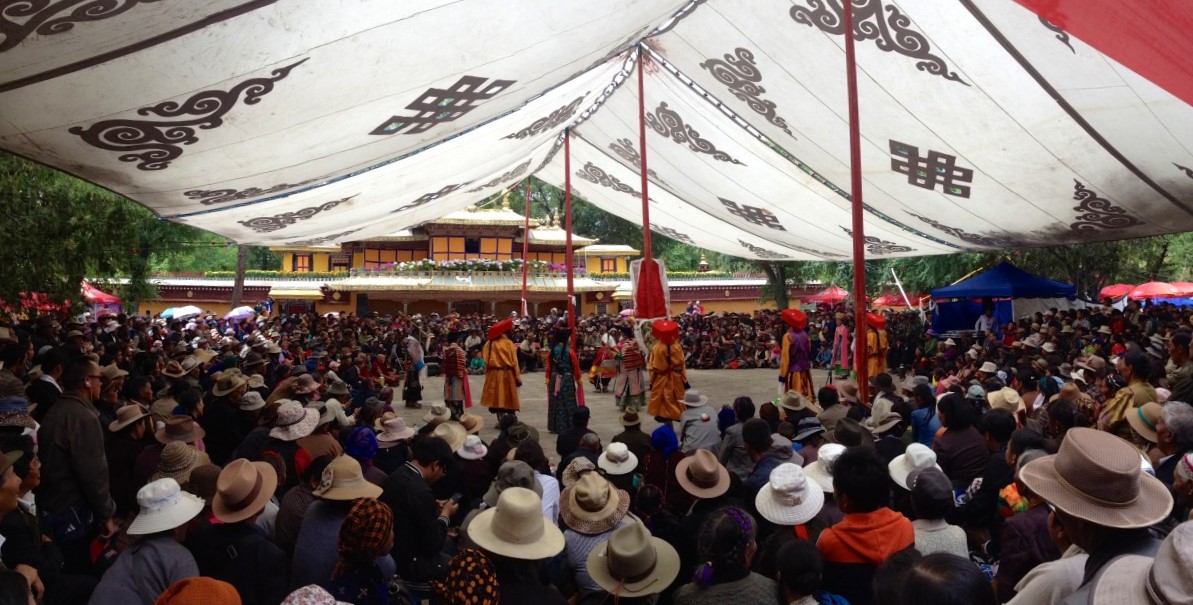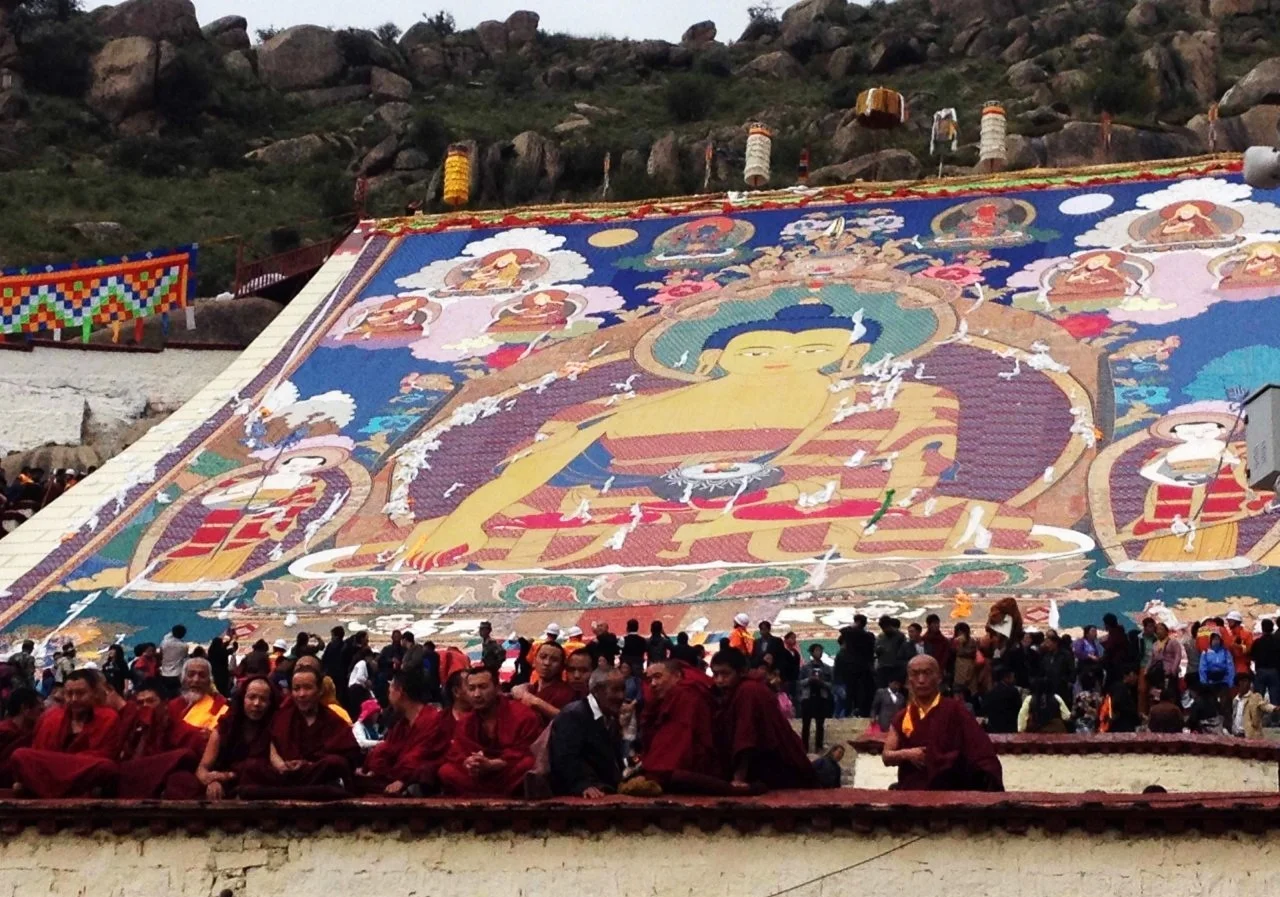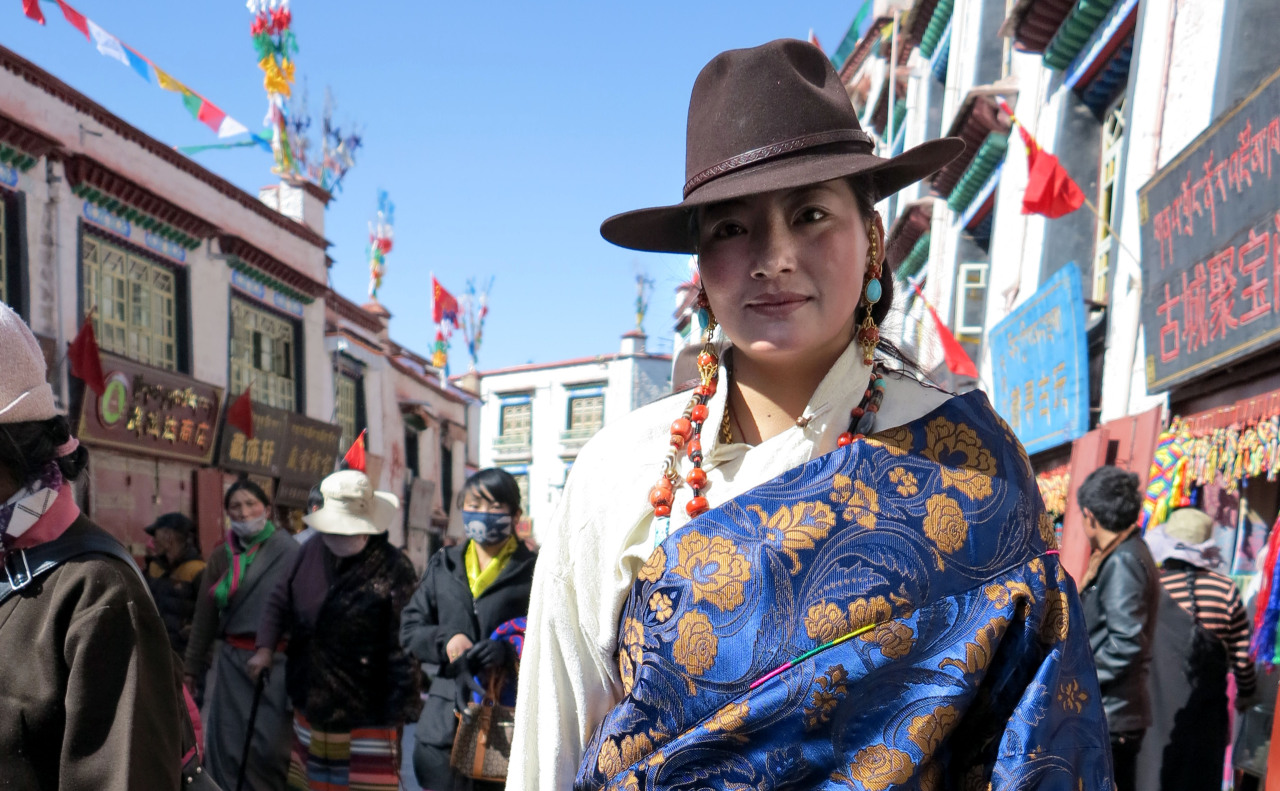Lhasa locals gather in the Norbulinka Summer Palace to watch traditional Tibetan Opera performances during Shoton Festival in summer.
For the ultimate cultural experience, nothing can beat a festival in the land of snows.
There's something so enchanting about Tibetan festivals - the rich colours of the Buddhist robes, the warm smell of butter lamp candles, the melodious chanting of prayers punctuated with droning trumpets and thundering drumbeats, and of course the enthusiastic atmosphere created by the local pilgrims and monks in attendance.
All across the Tibetan plateau various different festivals are celebrated, each with their unique practices and traditions. From the month-long Saga Dawa (often in May/June) during which thousands of Tibetans renounce meat, to the sunrise unveiling of a giant thangka at Drepung and Sera Monasteries in Lhasa, to the lighting of thousands of butter lamps in towns and villages across the country. Eastern Tibet's Kham and Amdo regions are well known for their horse racing festivals, while central Tibet's monasteries take center stage for a number of important days throughout the year.
Out of all the festivals in Tibet, we've got a few favourites of our own. Which ones appeal to you?
Here are our picks for the top 5 festivals to visit in Tibet:
1. Shoton (Yoghurt) Festival, Lhasa.
August 11 - 16, 2018 / August 30, 2019
This week-long festival in the Tibetan capital of Lhasa begins at sunrise with the grand unveiling of a giant thangka (embroidered image of the Buddha) that is only brought out for this one day, once a year. Drepung Monastery and Sera Monastery - the two largest monasteries in Lhasa - each have their own thangka, which are simultaneously unravelled, but devoted pilgrims who wish to see both usually begin at Drepung in the morning, then carry on to Sera for the afternoon. The ceremony involves dramatic traditional music with much clashing of cymbals and pounding of drums, and a ritual dance by trained monks. Thousands of local pilgrims queue for hours to see the thangka and receive a blessing from it.
After the first day, the environment relaxes as Lhasa locals all spend a week's holiday picnicking at the Norbulinka (the summer palace of the Dalai Lama) and watching Tibetan Opera performances in the park.
The giant thangka at Drepung Monastery in Lhasa.
2. Butter Lamp Festival, All Over Tibet
Dec 2, 2018 / Dec 21, 2019
To celebrate the achievements of the great Tibetan saint-scholar Je Tsongkhapa, people across the country lights tens of thousands of butter lamps in every monastery and ordinary house's windows and rooftops. Known in Tibetan as "Ganden Ngamchoe", it has become famous in English as the "Butter Lamp Festival". Je Tsongkhapa was responsible for creating the Gelug, or "Yellow Hat", school of Tibetan Buddhism, of which the Dalai Lama is now the head.
In Lhasa, hundreds of locals and tourists pack into the Barkhor Square to see the lamps lit on the roof, balconies, and windows of the sacred Jokhang Temple. In Kangding and other towns across eastern Tibet families spend the day in the monasteries helping to fill empty lamps with yak butter, ready to light at night.
The Butter Lamp Festival in Kangding, Kham.
3. Tsurphu Monastery Festival, Lhasa
May 24, 2018 / June 12, 2019
The head monastery of the Kagyu school of Tibetan Buddhism, and home of the Karmapa Rinpoche, is tucked away in a narrow valley west of Lhasa. Not many tourists visit Tsurphu, making it an ideal place to have an authentic festival experience, surrounded by Tibetan pilgrims from near and far, immersed in the Buddhist culture.
For three days monks perform symbolic dances while wearing elaborate costumes and masks, representing and embodying different deities. Interspersed are comedic acts with laypeople dressed as clowns, yaks and snow lions who entertain the crowd to lighten the mood. It's a jovial experience that has everyone laughing.
Monks in elaborate costumes and masks parade around the courtyard during the Tsurphu Monastery festival and cham dance performance.
4. Yushu Horse Racing Festival, Kham
July 25 - Aug 1, 2018 & 2019
Khampa people are known for being the horsemen of Tibet - wild and strong, fierce on horseback, but lovers of having a good party! Horse racing festivals are a highlight of any trip to the Kham region, and are also popular in Amdo. The horse racing festival at Yushu is one of the biggest events of the year in eastern Tibet, and a unique experience for any visitor.
For a week, watch as Tibetan men show off their talents on horseback, performing acrobatic tricks such as standing, firing a bow and arrow at targets, and sweeping up scarves from the ground while at gallop. There are also yak races and a full carnival of fun and games for families to enjoy. This is nomad Tibetan culture on display at its finest, as the empty grasslands fill with traditional yak hair tents as families pour into the area, wearing their best new clothes. Mingle with local people, and have the experience of a lifetime.
An agile rider shows how he can lower himself to the ground, and then pull himself up again, during the horse racing festival in Tibet.
5. Cho-Kor/ Ri-Kor Festival, Lhasa
July 16, 2018 / August 4, 2019
The whole of Tibet celebrates the Cho-kor festival - the anniversary of the day the Buddha first "turned the wheel of dharma" by teaching his disciples about the four noble truths. But in Lhasa the celebration is unique - hundreds of people take to the mountains to complete a day-long pilgrimage from hermitage to hermitage across the mountains that form the northern border of Lhasa city. This pilgrimage is called the "Ri-Kor", or "Mountain Circuit".
From early in the morning friends, families, young children and grandparents walk along the old mountain trails from Pabonkha Monastery to Sera Monastery, via 3 or 4 different hermitage retreats. They carry with them new prayer flags to hang from the mountain, and bags full of juniper and dried herbs to burn in piles of incense. Many sing and tell jokes as they walk, and at lunchtime stop to play games as they picnic high on the mountainside with panoramic views of Lhasa city below.
A Tibetan woman waits for her friends in the mountains, during the Rikor festival.
Bonus: Losar, All Over Tibet
February 5, 2019
The Tibetan New Year is usually a time for Tibetan people to be with their families and at home, similar to Christmas in the west. However, for tourists it can still be a beautiful time to be in Lhasa as people come to the holy city from all corners of the plateau wearing their best new clothes and showing off the fashionable dresses and jewelry of their home region. In Amdo, at Labrang and Langmusi Monasteries, the ceremonies to welcome in the new year go for days and involve displays of painted butter sculptures. People from all of the surrounding villages come to the monastery for blessing and to see the celebrations for the new year begin.
A Tibetan woman from Kham walks the Barkhor in Lhasa during Losar.









